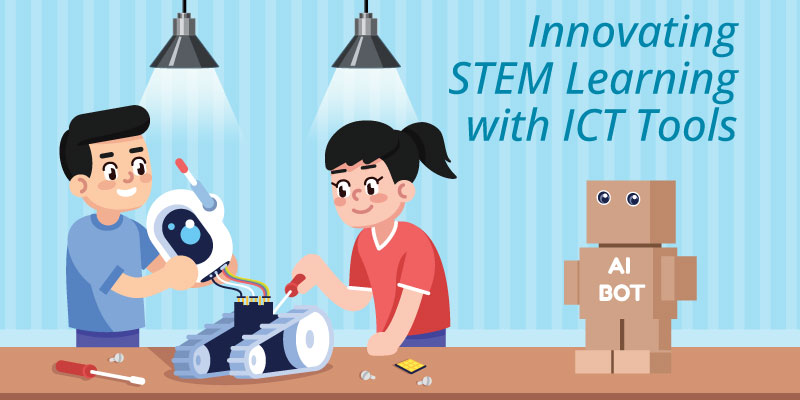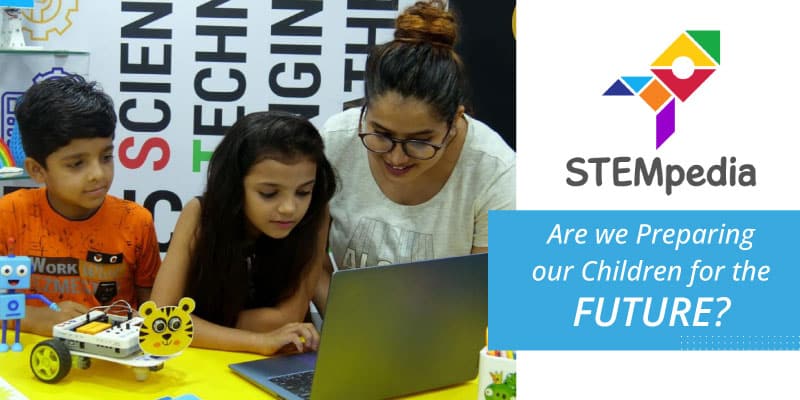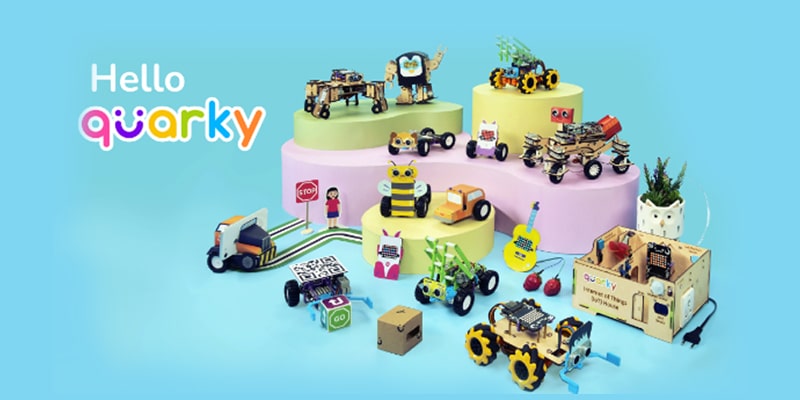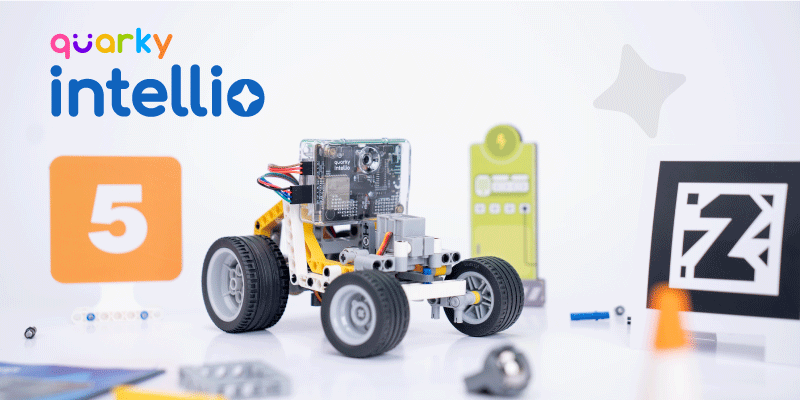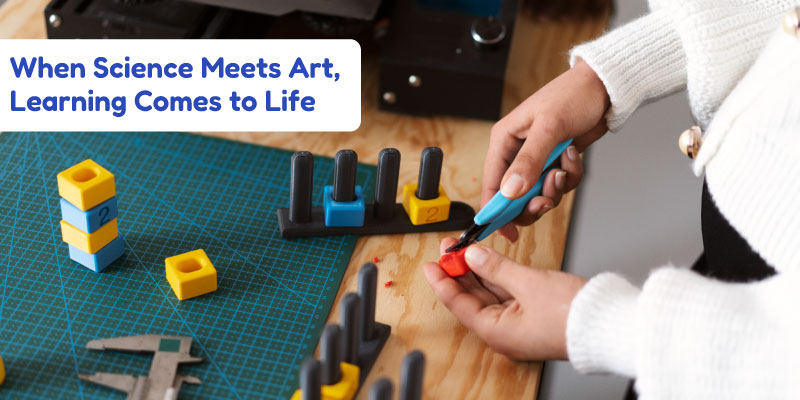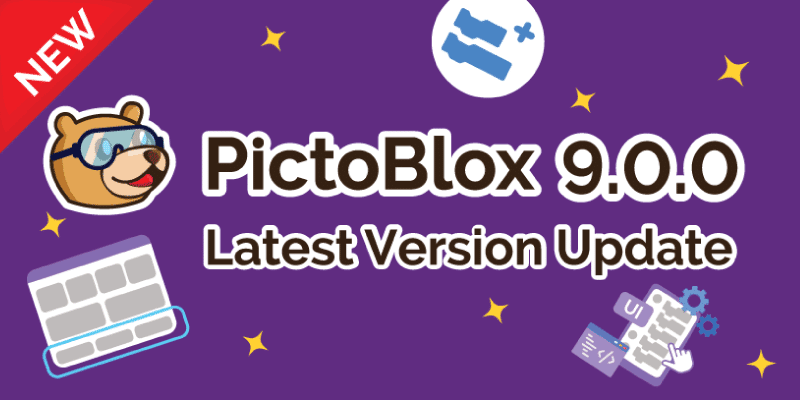Have you ever wondered how we can transform traditional STEM education into a captivating and interactive student experience? The answer lies in the revolutionary landscape shaped by ICT tools. Engaging students in Science, Technology, Engineering, and Mathematics (STEM) subjects is essential in a world where knowledge is evolving remarkablely.
Imagine a classroom where students are not merely spectators but active participants, immersed in hands-on learning experiences that fuel their curiosity and creativity. Continue reading to understand the importance of ICT tools in education. Also, explore the role and offerings of STEMpedia in this evolving educational landscape.
What Happens When STEM Learning Moves from Textbooks to Technology
Traditional STEM education often followed a one-size-fits-all approach. As a result, this limits student engagement and hinders personalized learning. Classrooms were dominated by textbook-based instruction, making it challenging to spark students’ curiosity and link theoretical knowledge to real-world applications. This static learning environment struggled to meet the diverse needs of 21st-century learners, highlighting a pressing need for transformation.
The involvement of ICT tools in education can revolutionize 21st-century learning by turning these challenges into opportunities. The EdTech tools can transform education by:
- Making learning dynamic and interactive through resources like simulations, coding platforms, and virtual labs
- Bridging the gap between theoretical knowledge and practical application by making complex concepts more understandable
- Catering to various learning styles and promoting team building, critical thinking, communication, and other essential skills for Industry 4.0
Let’s further understand the concept through a real-life scenario transformation:
- Before ICT tools, students could only visualize the solar system through textbook illustrations
- After using ICT tools, students explore space in a virtual environment, deeply understanding the solar system’s scale and dynamics
This shift from passive to active learning has shown remarkable results. A case study by Microsoft at the Sammamish High School reported a significant increase in student engagement and understanding.
- The study reported a 20% increase in AP pass rates, especially in STEM content areas like Biology, Chemistry, Statistics, Calculus AB/BC, Physics, and Environmental Science
- Additionally, there was a 20% increase in students with disabilities and limited English proficient students enrolling in AP STEM classes
- They also witnessed a 10% annual improvement in the state science test for all students
The transition to ICT-enhanced education represents a leap towards engaging, personalized, and effective learning, preparing students for the challenges and opportunities of the future.
Why Educational Institutions Should Consider Adding ICT Tools to Their Curriculum
Students and teachers face significant challenges in traditional STEM education. These include a lack of engagement, difficulty understanding complex concepts, and the inability to link theory with real-world applications.
Understanding the need for quality education, CBSE and ICSE introduce ICT tools into this traditional setting. The inclusion can majorly impact the various aspects of STEM education, such as:
- Adding to teacher competencies
- Diversifying the learning resources
- Increasing student and teacher motivation/engagement
Current industry trends emphasize the growing importance of digital literacy and technical skills, where traditional education systems lag. Institutions not integrating ICT tools in education risk leaving their students unprepared for a digital future. As a result, they miss out on:
- A 50% higher demand for digital skills in the workforce
- A 30% increase in job opportunities for tech-savvy professionals globally
- Over 60% of educators believe ICT tools significantly enhance student engagement and understanding
Students need to incorporate these tools to ensure they get opportunities to develop essential skills and explore innovative fields.
Institutions adopting ICT tools in education are seeing their students excel. Some students represent India at Codeavour, the world’s largest AI, robotics, and coding competition for students.
This showcases the global level of competence Indian students can achieve with the right tools.
ICT tools in education enhance STEM learning and equip students with the skills needed for these cutting-edge professions. Some of the most prominent professions include:
- Data Scientist
- Game Developer
- Software Engineer
- Biomedical Engineer
- Drone Operator and Developer
STEMpedia’s Role in Evolving the Educational Landscape with Diverse ICT Tools
STEMpedia is an innovative tech-education platform offering AI, coding, robotics, ML, and AR/VR for K-12 students and teachers. Understanding the need to include ICT tools in education, STEMpedia has developed various products and offerings. These include:
PictoBlox: Al, and Coding Educational Software
PictoBlox is revolutionizing the educational landscape by offering a dynamic platform for learning AI, coding, ML, and AR/VR. Its Block-based and Python programming interface makes the complex world of coding accessible and fun for students.
PictoBlox and its junior blocks (classes 1 and 2) will help students create software, apps, animations, games, websites, and projects in DIY electronics, IoT, robotics, AI, ML, and AR-VR, turning them into active creators and problem-solvers.
The versatile tool currently has 180k+ Monthly Active Users with a total user base of 1.1M from 90+ Countries.
It has been the foundation for numerous innovative and award-winning projects at Codeavour International, showcasing its versatility and impact in educational technology. Notably, projects like:
- Soil Doctor, a smart agricultural tool
- Dector, an inventive detection system
- Water Recycling System, a sustainable approach to water conservation
highlight how PictoBlox empowers students to tackle real-world problems with creative technological solutions.
Quarky: DIY Al and Robotics Kit
Quarky is a reprogrammable robot for students aged 7 to 14. By breaking complex concepts like ML (self-driving cars), face recognition (face unlock), and speech recognition (Alexa), Quarky makes learning interactive and engaging.
Its plug-and-play interface simplifies the connection of electronic components, fostering an environment where beginners and experienced learners can dive into coding, AI, and physical computing. With add-on kits like the Mars Rover and Quadruped Robot, Quarky enables students to create 15+ innovative projects.
This approach equips students to deeply understand industry-standard AI and robotics concepts. It cultivates problem-solving skills and creativity, making Quarky an essential tool in integrating diverse ICT into education.
Evive: STEM DIY Prototyping Tool
Evive enables students and creators to dive deep into electronics, robotics, IoT, and programming. Its user-friendly interface, complemented by plug-and-play hardware compatibility, empowers learners to seamlessly build and experiment with diverse DIY projects.
From creating smartphone-controlled robots and interactive games to constructing a touching piano or a line-following robot, Evive offers endless exploration and learning possibilities. By integrating with Arduino and MATLAB, Evive makes advanced technology accessible, encouraging hands-on learning and nurturing future innovators in a fun and engaging way.
Wizbot: Play – Code – Learn Using Your Smartphone
Wizbot is an affordable Foundational Literacy and Numeracy (FLN) and Computational Thinking (CT) education tool. It enhances young learners’ basic mathematics, logical reasoning, and STEM skills. Wizbot, the toy-based learning tool, enables students and creators to dive deep into electronics, robotics, IoT, and programming.
Its user-friendly interface, complemented by plug-and-play hardware compatibility, empowers learners to seamlessly build and experiment with diverse DIY projects. From creating smartphone-controlled robots and interactive games to constructing a touching piano or a line-following robot, Wizbot offers endless exploration and learning possibilities.
By integrating with Arduino and MATLAB, Wizbot makes advanced technology accessible, encouraging hands-on learning and nurturing future innovators in a fun and engaging way.
NEP 2020-led Curriculum for CBSE, ICSE, and IB Schools
To promote STEM learning, STEMpedia, the leading platform for K-12 education, introduces two new programs. Firstly, the Skillful Minds with CBSE ICT, coding, robotics, and AI curriculum (CBSE Subject Codes 417 and 843). Then comes the Tech Tinkerer program for ICSE AI, robotics, and coding ( ICSE Subject Code 66).
These programs perfectly align with NEP 2020 guidelines and NCF 2023 framework, offering a comprehensive learning experience for classes 1 to 8. The NIPUN Bharat-based initiative aims to democratize AI skills, address societal inequities, and promote responsible AI development for global leadership.
Apart from these programs, STEMpedia also offers CBSE computer books without ICT for classes 1 to 8 through Digital Wizards. Additionally, to cater to the interests of class 9 and 10 students, we offer AI books for CBSE and Robotics and AI books for ICSE schools.
AI and Robotics Lab
STEMpedia’s AI and Robotics Lab is transforming the educational landscape by providing a comprehensive ecosystem for coding, AI, and robotics education. Aligning with the vision of NITI Aayog and AIM, this initiative embodies the commitment to skill education, offering DIY Robotics kits, coding software, a grade-wise certified curriculum, teaching resources, and a learning management system for a hands-on learning experience.
With 300+ AI and Robotics labs and 500+ ATLs established, STEMpedia is dedicated to making AI technology accessible and empowering students to explore the boundaries of what is possible. This dynamic lab environment equips students aged 7-18 with 21st-century skills, encouraging them to master coding, problem-solving, and advanced technological concepts through practical, activity-based learning.
Catering to premium CBSE, ICSE, and international schools, STEMpedia is setting a new standard in K-12 education, fostering a generation of innovators and entrepreneurs ready to tackle future challenges.
In a Nutshell
ICT tools in education are revolutionizing STEM learning by making it more engaging, interactive, and accessible. The need for such innovation stems from recognizing technology’s vital role in today’s world.
STEMpedia, the driving force behind K-12 education’s transformation, has recognized the crucial role of ICT tools in making STEM learning more dynamic, interactive, and widely accessible. In response, STEMpedia developed flagship offerings like PictoBlox, Quarky, Evive, Wizbot, and the AI and Robotics Lab, alongside NEP 2020 and NCF 2023-aligned curricula for CBSE, ICSE, and IB schools.
These innovations withstand the government’s initiative to integrate AI for All, enhancing AI in education and preparing learners for a technologically driven future. To learn more about our offerings or to book a free demo, contact us at contact@thestempedia.com.

